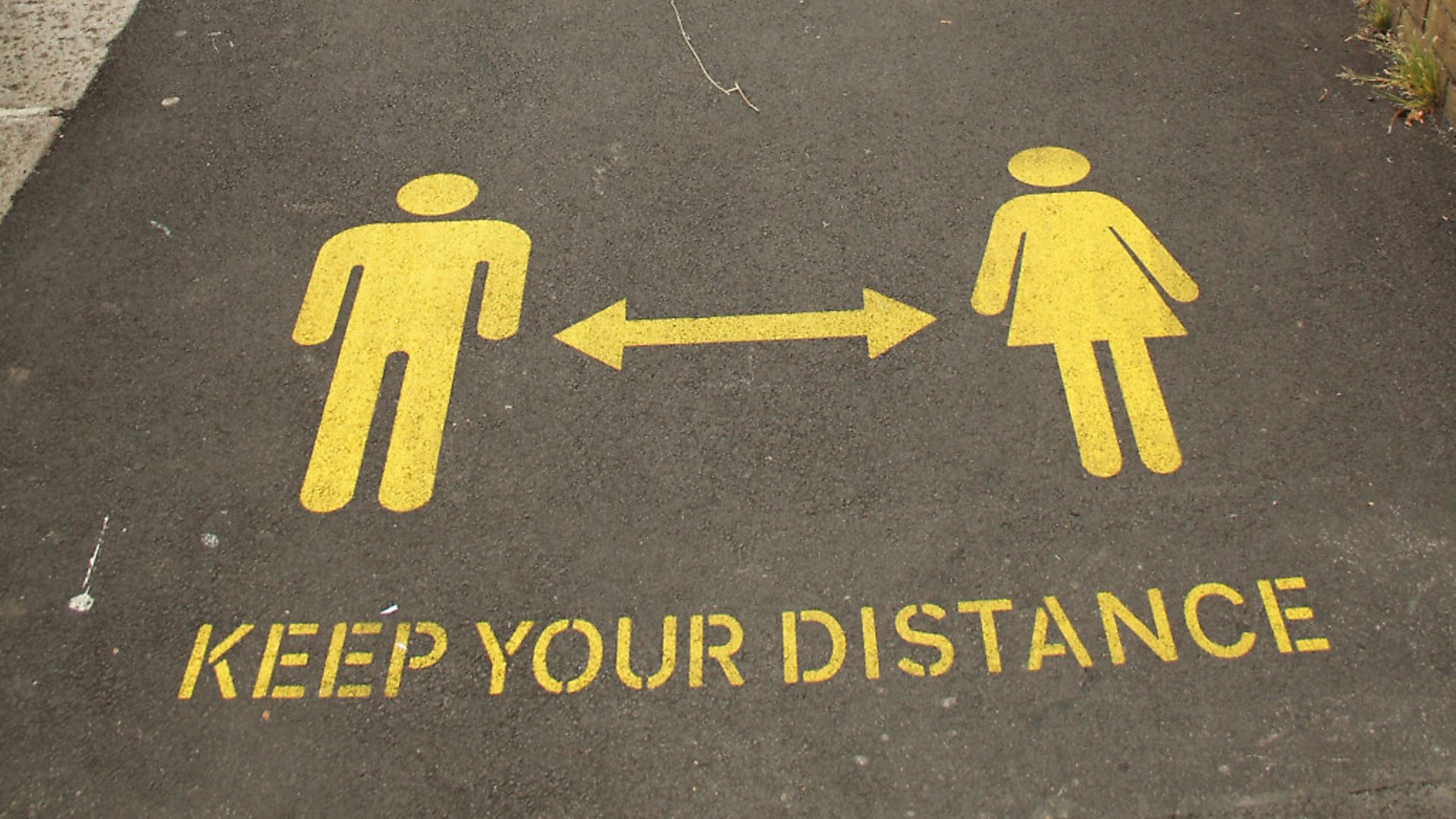
Our towns and cities have changed again because of the coronavirus. WILL SELF points out you can’t go far without seeing new signage.
The arrival in streets and shops of stickers and signs advertising the need to maintain a two-metre distance from fellow citizens reminds us to read the city not as a mere agglomeration of buildings and people, but a palimpsest: a manuscript upon which successive layers of text have been superimposed. Because there aren’t just bits of writing here and there – there are also strips of striped tape, yellow-and-orange or blue-and-white, that form the straight lines within which human exercises are supposed to be neatly inscribed.
The tape has been around for a while – for years now, steel barriers or fences have had shreds caught up in them, the traces left behind by this mob or that criminal outrage. And lest we feel the city offers no punctuation – no rest from its data-stream – I call your attention to the ellipses, or leader dots that spatter many a plate glass window. These do indeed call our attention to what’s been omitted from the scene: namely the hard materiality of these otherwise transparent surfaces. I remember eating in the trendy new Oxo Tower restaurant in the mid-1990s with an architect friend who pointed these out to me for the first time, as an innovation designed to protect the myopic, or otherwise partially sighted, from head-on collision.
And then there’s all the similarly conducive road signage, which attempts to divide up the available roadway between the marauding hordes of snorting motor vehicles, grunting cyclists and wheezing pedestrians. These injunctions: to drive here and not there – to keep in this lane, to not exceed this speed; to go now, and stop… now! are seamlessly incorporated into our flow-states of locomotion, such that we all become our own self-driving cars (or bicycles for that matter). The Dutch traffic engineer, Hans Monderman, came up with the idea that by eliminating all these objectified imperatives, drivers – and other road users – would be returned to the fact of their own autonomy, and so behave more safely and considerately. Every town and city where Monderman’s ideas have been tried has experienced a reduction in accidents and attendant fatalities.
Not that you’d know it in contemporary Britain – where what permissively shared-use roadway we have is mostly in the form of ‘shopping areas’. Here, while there may be some dialling-down of stentorian traffic signs, the advertising is usually cranked right up. Video-display units and electronic signboards are in the avant garde – but in less highly-developed town centres you can still see mechanical billboards that either rotate a series of advertisements like endless strips of hand-towelling, or offer up images cut into strips and affixed to triangular batons which revolve so as to display a tripartite icon of the holy consumer lifestyle.
And of course, lest we fall victim to a sense of cultural history as foreshortened as the bonnet of a bubble car, we should note the old-fashioned static billboards that remain, bellowing silently on traffic islands – and the posters slapped screeching across shop windows. These represent another kind of ellipsis – one increasingly directing our attention to the commerce that’s missing. Yes, there’s nothing remotely new about what Walter Benjamin termed ‘vertical type’: as soon as the technological means existed to print posters in large numbers, the buildings of the great cities were wrapped up in them. By the time of the belle époque, Paris resembled a sort of giant pass-the-parcel, half-unwrapped and tatty – the only things that remain from this era are the signs proclaiming ‘Défense d’afficher!’ as if there had once been a bureau of preventative crime which had acted with consummate efficiency.
There are these remnants – and there also the revenants of hand-painted advertisements from earlier eras. Particularly prominent around my way is one for Germolene antiseptic on a gable end beside the Wandsworth Road, and further along there’s a little chap in pantaloons proclaiming the delights of Peterkins Custard, whatever that was. I find great pathos in these faded injunctions; if – following Marx – we view the commodity form as a screen on to which we project the warped apprehension of our own social relations, then what are these, if not fetishes that have lost their mystique: hairballs and bone-bags, desiccated and fading in the harsh light of the 21st century.
If you think me fanciful, consider this: the most prominent ghost ad’ in my immediate vicinity is one for Craven As that takes up two-storeys of an end wall set perpendicular to the Brixton Road.
These cork-tipped cigarettes were urged upon consumers with this still legible slogan: ‘For your throat’s sake smoke…’ I’m sure you’re wondering along with me, whether all the vertical – and horizontal – type associated with the Covid 19 pandemic will acquire, in retrospect, the same sense of almost cosmic wrong-headedness.










